9+ English Report Writing Examples
English report writing is a crucial skill that involves organizing information clearly and concisely to inform or persuade the reader. This form of writing is essential in many professional and academic settings where the ability to communicate information effectively is key. Whether you’re a student looking to ace your assignments, a professional aiming to compile analytical reports, or simply someone interested in improving your writing skills, mastering English report writing can significantly enhance your ability to convey your ideas clearly. This guide will cover the basics of report writing, provide tips to improve your writing skills.
What is English Report Writing?
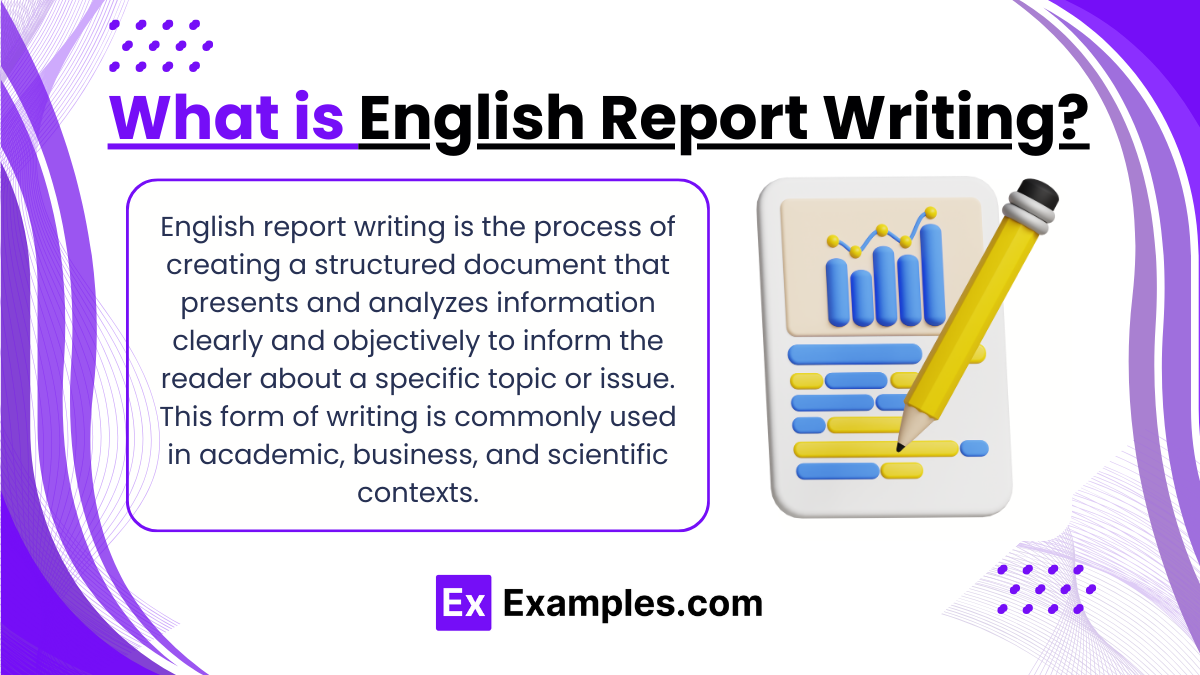
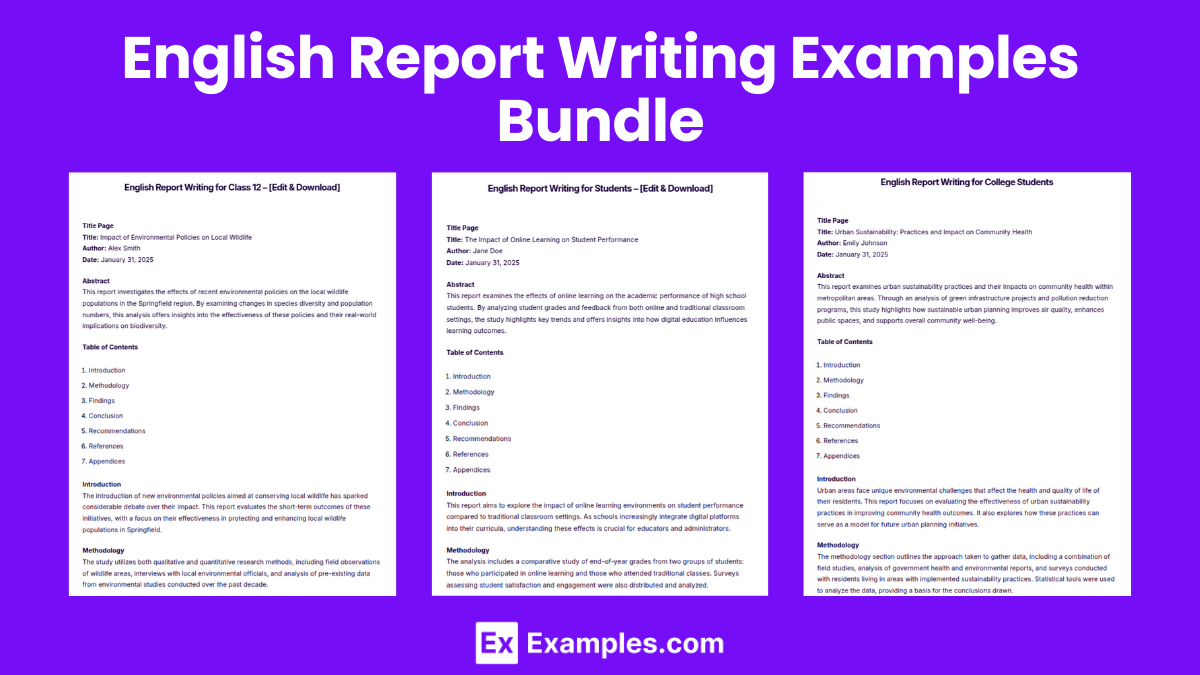
English Report Writing Examples Bundle
English Report Writing Format
Title Page
The title page includes the report’s title, the author’s name, and the date of submission.
Abstract
An abstract is a brief summary of the report, outlining the main points and conclusions. It is typically about 200-300 words long.
Table of Contents
This section lists the titles of the chapters and the page numbers to help readers navigate the document.
Introduction
The introduction sets the context for the report, outlines the problem or research question, and states the report’s objectives.
Methodology
This part explains how the data was collected or the research was conducted, including any tools or approaches used.
Findings or Body
The body of the report presents the data or information discovered during the research. It is organized into sections and subsections to discuss various aspects of the topic.
Conclusion
The conclusion summarizes the findings, reaffirms the importance of the data or research, and may suggest recommendations based on the findings.
Recommendations
(Optional) Recommendations are suggestions or actions that should be taken based on the report’s findings.
References
List all sources used in the preparation of the report, formatted according to a specific citation style.
Appendices
(Optional) Include any additional material that is relevant to the study but not integral to the report body, such as raw data or detailed analyses.
English Report Writing Example
Title: Annual Marketing Analysis Report
Author: John Doe
Date: January 31, 2025
This report provides an analysis of the annual marketing efforts of XYZ Corporation, focusing on the outcomes of various campaigns and strategies implemented throughout the year. The data collected from multiple platforms illustrates the impact on overall sales growth and brand awareness.
- Introduction
- Methodology
- Findings
- Conclusion
- Recommendations
- References
- Appendices
The purpose of this report is to evaluate the effectiveness of marketing strategies employed by XYZ Corporation in 2024. It aims to identify strengths and weaknesses in the approaches taken and provide insights into how these strategies have influenced consumer behavior and sales performance.
The analysis is based on quantitative data collected from digital marketing platforms, sales reports, and consumer feedback surveys. The methodologies applied include statistical analysis of sales data and measurement of engagement metrics across social media platforms.
The findings section discusses the results from the data analysis. It is organized into subsections by marketing strategy:
Social Media Campaigns: Increased engagement rates by 40% from the previous year.
Email Marketing: Highest ROI among all digital marketing efforts, with a 35% increase in conversion rates.
Influencer Partnerships: Contributed to a 20% rise in brand awareness among the target demographic.
The report concludes that XYZ Corporation’s marketing efforts have successfully increased sales and brand awareness, although some strategies have proven more effective than others. The overall performance indicates a positive trend in consumer engagement and sales growth.
Based on the findings, it is recommended that XYZ Corporation:
Increase investment in email marketing, as it yields the highest ROI.
Expand influencer partnerships to capitalize on brand exposure gains.
Reevaluate underperforming social media strategies to optimize resource allocation.
Smith, J. (2024). Marketing Metrics and Effectiveness. New York: Marketing Publishers.
Doe, A. (2024). Digital Marketing in Modern Business. Boston: Business Press.
Appendix A: Detailed Statistical Analysis
Appendix B: Survey Questionnaire Forms
English Report Writing Examples
English Report Writing for Students
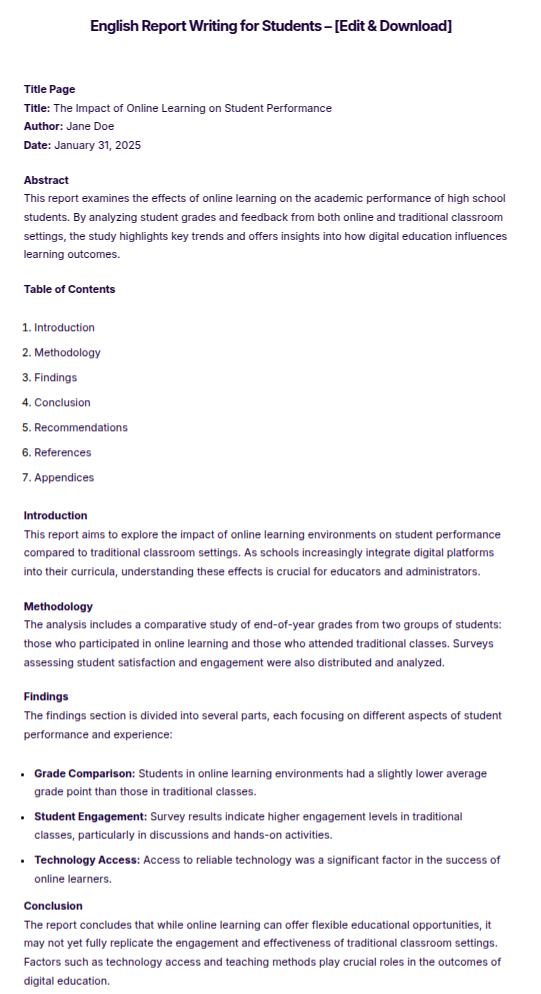
English Report Writing for Class 12
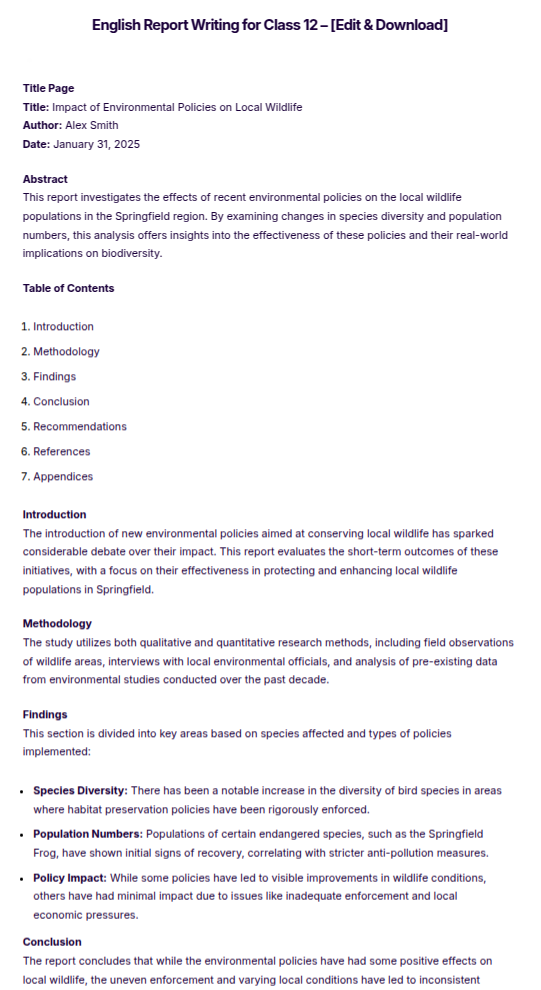
English Report Writing for College Students
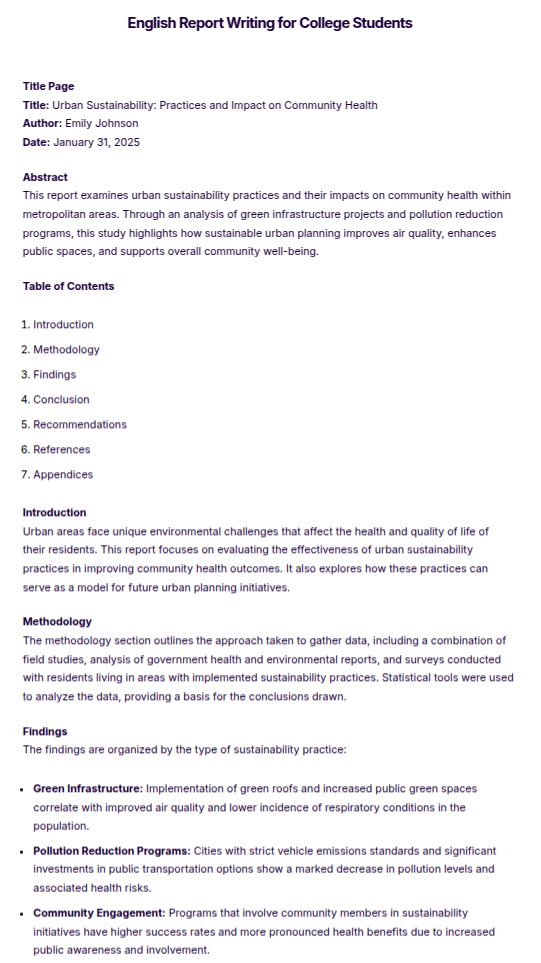
More Examples on English Report Writing
- English Report Writing for Class 11
- English Report Writing for Class 10
- English Report Writing for Class 9
- Chandrayaan 3 English Report Writing
- Business English Report Writing
- Igcse English Report Writing
- Simple English Report Writing
How to Write a English Report Writing
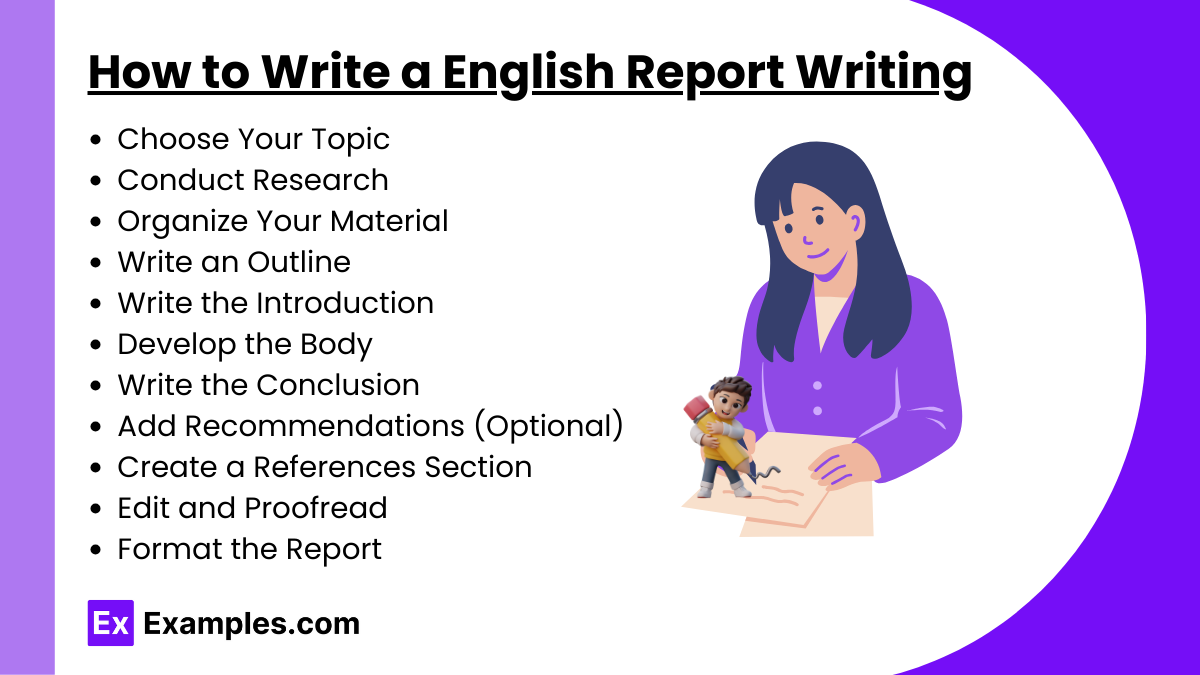
- Choose Your Topic
- Select a topic that fits the assignment’s criteria and interests you.
- Conduct Research
- Gather information from reliable sources like books, academic journals, reputable websites, and interviews.
- Organize Your Material
- Sort the collected information into categories related to different aspects of your topic.
- Write an Outline
- Draft an outline to structure your report, typically including:
- Introduction
- Body paragraphs (divided by subtopics)
- Conclusion
- Draft an outline to structure your report, typically including:
- Write the Introduction
- State the purpose of the report and outline the main points that will be covered. Provide background information to help the reader understand the context.
- Develop the Body
- Each section should focus on a specific aspect of your topic. Use clear headings and subheadings to organize the content. Support your points with facts, statistics, and examples.
- Write the Conclusion
- Summarize the main findings and restate their importance. Reflect on the implications of your findings and suggest potential future actions or studies.
- Add Recommendations (Optional)
- Provide practical and feasible recommendations based on the findings of your report.
- Create a References Section
- List all sources used in your research following the specified citation style (e.g., APA, MLA).
- Edit and Proofread
- Check for grammatical, punctuation, and spelling errors. Ensure the information flows logically and that the report is coherent.
- Format the Report
- Ensure that the report is formatted according to assignment guidelines, including font size, margins, and title page details. Add required elements like page numbers, a table of contents, or appendices.
Tips for Writing English Report Writing
- Understand the Purpose: Clearly understand what the report is meant to achieve. Know whether it’s to inform, analyze, persuade, or present data.
- Plan Your Content: Before writing, plan the structure and content of your report. Make an outline to organize your thoughts and ensure a logical flow of information.
- Keep It Concise: Use clear and concise language. Avoid unnecessary jargon and complex sentences that could confuse the reader.
- Use Formal Language: Maintain a formal tone throughout the report. Use professional vocabulary and avoid slang or colloquial expressions.
- Incorporate Visuals: Enhance your report with charts, graphs, and tables where appropriate. Visuals can help clarify complex data and make the report more engaging.
- Cite Sources: Always cite your sources to give credit for the information you’ve used and to lend credibility to your report.
- Review and Revise: After writing, take time to review and revise your work. Check for errors in grammar, punctuation, and spelling, and make sure all information is accurate and relevant.
Guidelines for English Report Writing
- Clear Structure: Organize your report with a clear structure, including an introduction, body, and conclusion. Use headings and subheadings to break down sections for easy navigation.
- Concise Language: Write concisely and clearly, avoiding overly complex sentences and jargon. Aim for straightforward communication that is easily understandable.
- Evidence-Based: Support your analysis and conclusions with concrete evidence. Use data, case studies, or quotes from credible sources to back up your points.
- Proper Formatting: Adhere to specific formatting guidelines such as font size, margins, and spacing. Include a title page, table of contents, and references.
- Review and Edit: Proofread your report to correct grammatical errors and ensure clarity in your arguments. Consider having someone else review it to catch errors you may have overlooked.
FAQs
How should I structure the body of an English report?
The body should be divided into sections and subsections, each addressing a specific aspect of the topic, supported by evidence.
What style should I use in English report writing?
Use formal language, clear and concise expressions, and avoid slang or colloquial terms to maintain professionalism.
How do I choose a topic for an English report?
Select a topic that matches the assignment’s criteria, ensures sufficient available information, and aligns with your interests.
How do I conclude an English report?
In the conclusion, summarize the key findings, restate the importance of the topic, and, if applicable, provide recommendations based on the analysis.
Why is it important to cite sources in a report?
Citing sources is crucial for crediting original authors, avoiding plagiarism, and lending credibility to your report.


